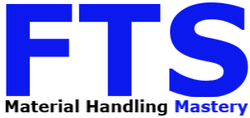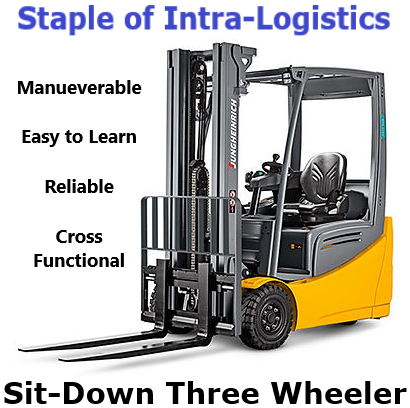
Regarding forklift purchases, it can get confusing, especially if it is for a start-up, relocation, or reconfiguration. There is a lot to get wrapped up in, especially if experience with electric trucks and specifically three-wheeled electrics, is limited.
It has to be said that this is not a comparison to the stand-up counterbalance truck even though very often are competing choices when buying, which doesn’t make it any easier to make a decision you feel great about. With that in mind, there are benefits, cons, and more favorable applications to both. As for applications, however, a citation where operators do a lot of off-and-on would be favorable for the stand-up, but keep in mind that it is a little harder to train operators on proper use.
To highlight the benefits of the three-wheeled sit-down forklift, three things will be covered;
Ease of Maintenance
Maneuverability
Ease of Training
Ease of Maintenance
When it comes to maintenance on a three-wheeled sit-down (SDTW) forklift, it is as easy as it gets. To start with, the battery compartment has a hood that can be lifted to let the hydrogen and heat out when the battery is being charged. The hood also allows the water levels to be checked and corrected if there is no filling system installed [not recommended], and also to perform other maintenance and checks on the battery without pushing the battery out onto a stand. This can save time and anguish, and all who work with batteries should wear the appropriate PPE.
Another cost of ownership perk to the sit-down three-wheeled sit down is that all electrics over Internal Combustion Engine (ICE) lift trucks is that it doesn’t need an oil change during the planned maintenance visit, which typically means a lower PM cost. The three-wheelers do require oils and lubricants but due to the lack of an engine, they don’t need them changed very often.
The last maintenance perk for the SDTW is the fact that there isn’t much to look at on an inspection. Given the overlooked importance of proper pre-shift inspections, this is a real win for the owners and users of three-wheel forklifts. If you catch it in the morning with the hood raised, follow along with an FTS custom inspection form from previous training, a speedy and proper inspection is a shoo-in. If the inspection is on a multi-shift unit, and the truck is already in action, then there may be a few seconds added for lifting the hood. With properly trained inspectors, the inspection can still be within 90 seconds without hurrying. This is because there is not much to the three-wheeled sit-downs, and the newer they are, the easier they are to inspect.

Click here to ask about FTS Training and Services
Maneuverability
The enhanced maneuverability of the modern SDTW gives it a substantial advantage over its taller 4-wheeled cousins and an even bigger advantage over the ICE trucks at the 4000# and below capacities. While all of the 4-wheeled trucks will have to make frequent “k” turns, properly used three-wheelers eliminate the extra moves with 0-turn capabilities. By having this ability, the three-wheeler can spin itself and land its forks exactly where its counterbalance is without changing its location, which among other things, allows for proper operation in tighter spaces.
Properly applying hyper-maneuverability doesn’t just save space, it also saves energy. If operators of the SDTW are properly trained and use them correctly, they will cover less ground and inevitably consume less power to get more done. Combine that with a top-tier efficiency Jungheinrich and the savings over time will be surprising.
Reduced exposure is another bi-product of a properly placed and operated three-wheeler, and not just by less movement, but also because it is more likely that operators will not swoop in aisles that they normally would with the four-wheeled trucks. This is due mainly because of its 0-turn ability, but also because of its heightened maneuverability in general. It speeds up the correct process when the machine can just line up more easily.
Ease of Training
For a beginner, learning to operate a sit-down style forklift is always easier to train on than a stand-up. That means an instant increase in the number of people who are candidates for operating them. With that said, a more maneuverable lift truck that is easy to line up is even easier to learn than its four-wheeled comparatives.
Furthermore, if converted from ICE or 4-wheel electrics, the controls, and operating principles are all the same, and the only thing that changes is the ease of maneuvering.
The versatility of applications that comes with the three-wheeled sit-down forklift also means reducing the number of Classes of trucks to be trained on and thereby reducing training time and per-visit cost if using an outside trainer. For example, instead of having propane trucks with rider jacks, just a three-wheeled electric might suffice, or even eliminating reach trucks while needing to also load trucks. Although sometimes reach trucks are unavoidable, a sit-down three-wheeler goes well with not much wider aisles. Different types [classes] of trucks
Whatever you decide on the current or next purchase, hopefully, this article helped and wasn’t too long to finish. If the info was helpful but going electric is still an issue, then check out the series on batteries.
By Dustin Link






